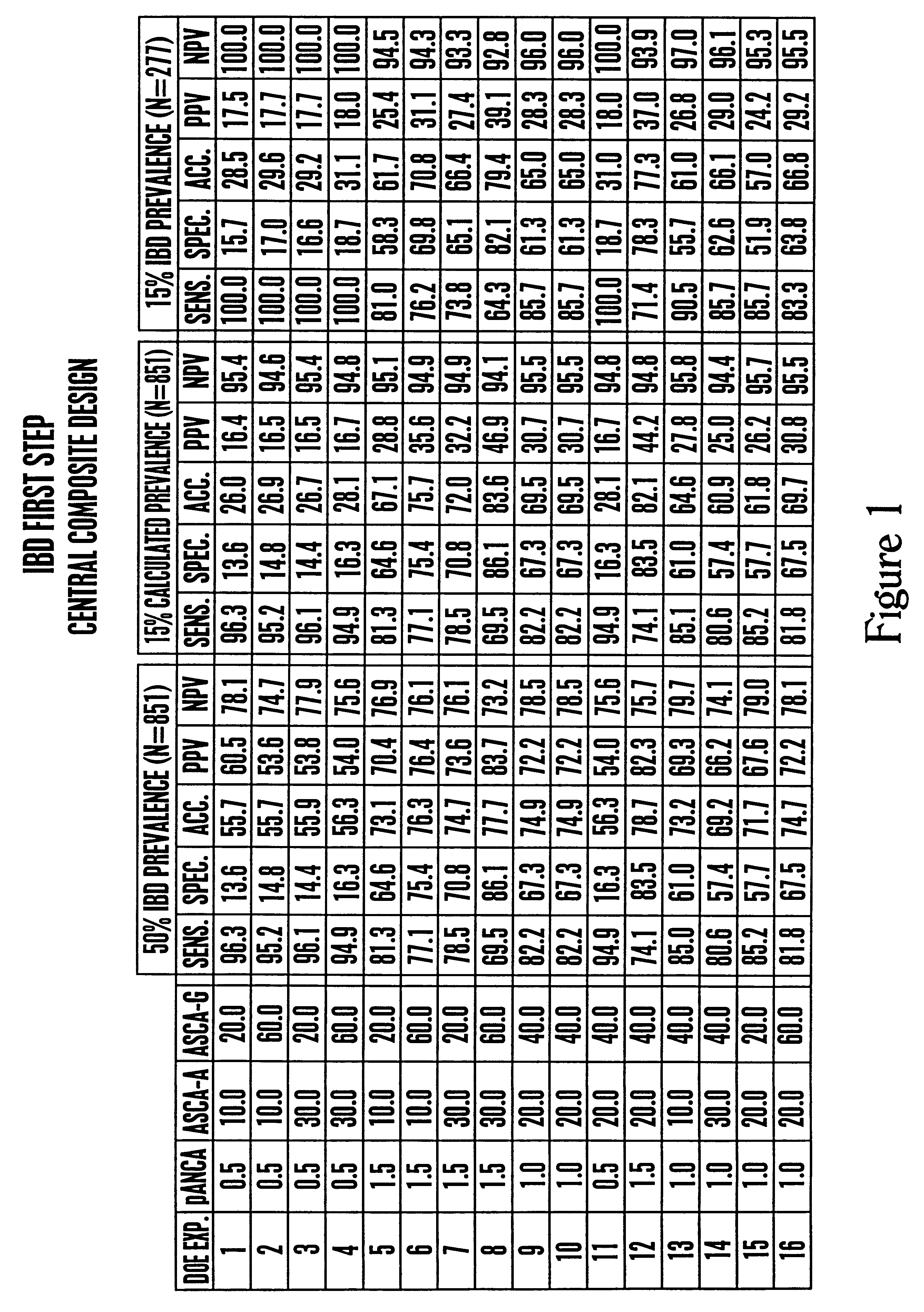Inflammatory bowel disease first step assay system
a technology assay system, which is applied in the field of inflammatory bowel disease first step assay system, can solve the problems the cost of ibd and ibs is compounded by the loss of productivity, and the determinant of these high medical costs
- Summary
- Abstract
- Description
- Claims
- Application Information
AI Technical Summary
Benefits of technology
Problems solved by technology
Method used
Image
Examples
example ii
Determination of Optimized Cut-Offs for ANCA, ASCA-IgA and ASCA-IgG Positivity
This example demonstrates that particular ANCA, ASCA-IgA and ASCA-IgG cut-off values can be selected to yield a preferred clinical parameter for diagnosing IBD.
A. Database Used in Analysis
Only quantitative ELISA procedures were performed and particular cut-off values for the results of each ELISA assay used to determine whether the test serum sample was positive or negative for markers of IBD. In particular, no immunofluorescence assay procedures were performed as part of these diagnostics.
The cut-off values for each of the three ELISA components of the assay were determined using a database consisting of serology data from 851 individuals (Table 1). The presence or absence of inflammatory bowel disease was made for all IBD patients by colonoscopic, radiologic, and / or histologic methods at Cedars Sinai Medical Center (Los Angeles, Calif.). Serum from 300 asymptomatic non-disease controls also was tested, a...
example iii
Use of the Sensitive `First Step` Method In Combination With Subsequent, Specific Diagnostic Assays
This example demonstrates that the "First Step" diagnostic method can be used in combination with subsequent, specific diagnostic assays such as the UC*Dx-1 and CD*Dx-1 assays.
Samples which were positive by "First Step" analysis (including true positive and false positive samples) were subsequently tested by the UC*Dx-1 and CD*Dx-1 assays, which are specific for ulcerative colitis and Crohn's disease, respectively. The results are shown in Table 8.
Together, reflex of samples positive by "First Step" analysis to the UC*Dx-1 and CD*Dx-1 performs with 66.3% sensitivity, 90.9% specificity, 72.2% negative predictive value, 88.3% positive predictive value and 78.4% overall agreement. These results indicate that subsequent analysis of positive samples can amplify on the initial "First Step" result. These results indicate that the "First Step" diagnostic can be used, if desired, in combination...
PUM
| Property | Measurement | Unit |
|---|---|---|
| OD | aaaaa | aaaaa |
| pH | aaaaa | aaaaa |
| concentration | aaaaa | aaaaa |
Abstract
Description
Claims
Application Information
 Login to View More
Login to View More - R&D
- Intellectual Property
- Life Sciences
- Materials
- Tech Scout
- Unparalleled Data Quality
- Higher Quality Content
- 60% Fewer Hallucinations
Browse by: Latest US Patents, China's latest patents, Technical Efficacy Thesaurus, Application Domain, Technology Topic, Popular Technical Reports.
© 2025 PatSnap. All rights reserved.Legal|Privacy policy|Modern Slavery Act Transparency Statement|Sitemap|About US| Contact US: help@patsnap.com

